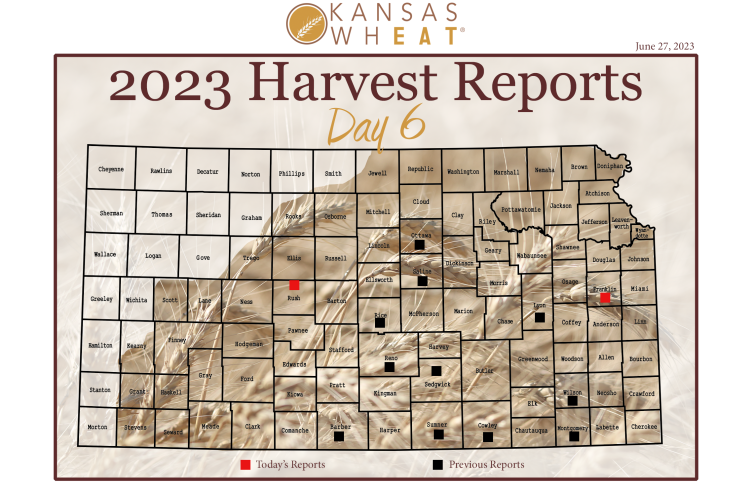Breadcrumb
- Home
- Day 6, Kansas Wheat Harvest Report
This is day 6 of the Kansas Wheat Harvest Reports, brought to you by the Kansas Wheat Commission, Kansas Association of Wheat Growers, Kansas Grain and Feed Association and the Kansas Cooperative Council.
Harvest continues to march across the state, moving into areas with higher abandonment, variability and pressure to get crops cut as unwelcome weeds take over short, thin stands.
Industry reports have indicated that early quality data from south central and central Kansas are showing good quality, with 60 pound test weights and above average proteins.
Troy Presley from CoMark Equity Alliance reported harvest began on June 8 and is now 50 percent complete. He expects the group’s approximately 75 locations in Kansas will take in about 40 to 45 percent of a normal crop. Yields range as low as five bushels per acre up to 40 bushels per acre, with anomalies in the 50s.
“There is still a lot to be determined in terms of abandonment, with all the weeds coming in,” he said.
The volatility in yields is due to farming practices and the previously planted crop. Overall test weights are averaging above 60 pounds per bushel and proteins are also much higher than average, with some variation.
This year’s challenges don’t end once the wheat is in the bin. Presley explained the group is also dealing with the inverted market environment, storage issues stemming from higher dockage from weeds, the logistics of the on-again, off-again harvest and trying to forecast whether farmers will sell now or store for later.
Weeds are also causing issues in central Kansas, but Dale Younker didn’t have any wheat of his own to harvest in northern Rush and southern Ellis counties. All of his winter wheat was appraised between 1.5 to 3 bushels per acre, so they terminated the entire crop and planted everything back to grain sorghum.
That wheat was appraised before any rain fell, so some fields could have yielded better. Short-term droughts are typical for this area in central Kansas, but he explained this dry spell goes back to fall 2021.
“I’ve been at this for 30 plus years, that I’ve been farming on my own,” Younker said. “And I do not remember a time when we were so dry for so long.”
Younker and his crew did break out the harvest equipment to help out a neighbor, cutting a few fields northeast of LaCrosse from Saturday afternoon to Monday afternoon. Yields were down significantly with one field making around 20 bushels per acre and the other in the low 30s. Test weights were a little down at 58.5 to 59 pounds per bushel.
The area has been receiving some rain since the first week of May but is either still in D4 (exceptional) drought or just out of it. As a result, Younker’s grain sorghum was planted in decent conditions, but more rain will be needed to take that next crop to harvest.
“That’s what we’re shooting for, that’s why we didn’t hesitate to put milo behind this failed wheat,” he explained. “That weather pattern is going to shift. And with the rains we did have, we had some good moisture to get that milo up and going and off to a good start.”
Far eastern Kansas farmers said they feel very fortunate to have received moisture earlier throughout the growing season, unlike producers in the western two-thirds of the state. Harvest should wrap up by the end of this week in Franklin County, according to Clark Wenger, general manager/CEO of Ottawa Coop. The area planted twice as many wheat acres this year and combined with an uncommon set of great growing conditions, the harvest is better than expected.
Area producers brought in a few loads on June 15, but harvest didn’t take off until June 19. Both HRW and SRW are planted in this area, about 30 percent soft to 70 percent hard. Yields for HRW are coming in up to 60 to 70 bushels per acre, with test weights at 60 to 61 pounds per bushel and proteins between 9 and 12 percent.
Summer storms are in the forecast, so stay tuned for the next report from the Kansas Wheat crew on Thursday, June 28.
The 2023 Harvest Report is brought to you by the Kansas Wheat Commission, Kansas Association of Wheat Growers, Kansas Grain and Feed Association and the Kansas Cooperative Council. To follow along with harvest updates on Twitter, use #wheatharvest23. Tag us at @kansaswheat on Facebook, Instagram and Twitter to share your harvest story and photos.
###
Written by Julia Debes for Kansas Wheat

